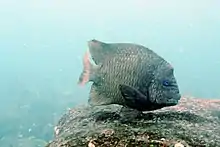| Giant damselfish | |
|---|---|
 | |
| Scientific classification | |
| Domain: | Eukaryota |
| Kingdom: | Animalia |
| Phylum: | Chordata |
| Class: | Actinopterygii |
| Family: | Pomacentridae |
| Genus: | Microspathodon |
| Species: | M. dorsalis |
| Binomial name | |
| Microspathodon dorsalis (Gill, 1862) | |
| Synonyms[2] | |
The giant damselfish (Microspathodon dorsalis) inhabit rocky reefs, below the surf zone at depths of 1–25 m. They feed mainly on low-profile, attached algae. They defend both feeding and reproductive territories by driving off other fishes and divers who come too close. They are oviparous, and form distinct pairings during breeding. The eggs are demersal and adhere to the substrate. Males guard and aerate the eggs.[3]
Distribution
Eastern Pacific: central Gulf of California to Malpelo Island (Colombia), including the Revillagigedo, Cocos Island and the Galápagos Islands.[4]
References
- ↑ Allen, G.; Robertson, R.; Rivera, R.; et al. (2010). "Microspathodon dorsalis". The IUCN Red List of Threatened Species. 2010: e.T183825A8183561. doi:10.2305/IUCN.UK.2010-3.RLTS.T183825A8183561.en.
- ↑ "Microspathodon dorsalis". WoRMS. World Register of Marine Species. Retrieved 2 June 2021.
- ↑ Encyclopedia of Life. "Details for: Giant Damselfish". Encyclopedia of Life. Retrieved 2013-07-15.
- ↑ Froese, Rainer; Pauly, Daniel (eds.) (2013). "Microspathodon dorsalis" in FishBase. July 2013 version.
External links
- Photos of Giant damselfish on Sealife Collection
This article is issued from Wikipedia. The text is licensed under Creative Commons - Attribution - Sharealike. Additional terms may apply for the media files.
